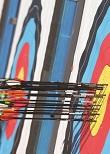
 Think for a minute about the sport of archery. You probably know at least one of these three things:
Think for a minute about the sport of archery. You probably know at least one of these three things:
Archery is an Olympic and Paralympic sport
Archery is more popular than ever, and that has something to do with “The Hunger Games”
There’s an amazing archer who shoots with his feet
Why do you know these things? Archery, a small sport with a big fun factor, started investing in social media over four years ago. Without any advertising budget or funds for promotional posts, two archery organizations bet staff time that social media efforts would pay off. And thanks to those efforts (and the help of Hollywood), archery has gone viral.
A huge part of archery’s social media model has been their coverage of national and international events. USA Archery – the sport’s national governing body – and World Archery – the sport’s international federation – both realized early on that event coverage was key to growing their events and the sport itself.
You might look at USA Archery’s Facebook likes or World Archery’s – hovering at 80,000 and 107,000 respectively – and scoff at those numbers. But before you do, consider that USA Archery has experienced 84% membership growth in just 12 months, with female membership up 105% in the past year alone. In other words, good social media practices translate into participation, which means increased revenue.
So which pages should you take from archery’s playbook? Here are a few suggestions:
You might have read that Facebook’s organic reach for brands is decreasing rapidly. What does this mean for you? Simply put, Facebook works to get brands to spend more money on advertising. Good content that is relevant to your audience will help you reach more people than anything else you can do on this platform. So what should you be posting?
Remember that only a fraction of your fan base – the people who “like” your page – will ever see the content you post. In general, the better your content is, the higher your engagement level will be (people who have seen your post and then liked it, commented on it, clicked through to your link, or shared the post). When one of your fans clicks “like,” makes a comment or shares your post, many of their Facebook friends – who may not be aware of your brand – then see your post. This is called “reach.”
The more your content is engaged with, the higher Facebook ranks it in their News Feed algorithm, which means it’s shown to more of your fans AND their friends. In other words: when your content is better, it will be shown to more of your fans, have better reach and higher levels of engagement, which increases your page likes and awareness of your brand.
Be sure your content has a visual component: an interesting and high-quality image, a video, or a link that has a photo preview. Facebook posts that are solely text-based, or links without photo previews, are shown to fewer fans – and get much less engagement – than visually based posts. However, be sure your photo or video adds value for your fan base. A good test: if you saw the photo in your news feed, would you take the time to give it a “like?” If the answer is no, it’s probably not worth posting.
Links to relevant articles on your website are almost always a winner, as long as you are giving the audience something that’s of value to them. This is important because many brands fall into the trap of communicating what they want to say, as opposed to what the audience wants to read, and then become disappointed when the content doesn’t do well on Facebook.
Avoid “advertising” language that promotes sales, discounts or “buy now.” This language will actually cause Facebook to hide your posts. Ditto for posts that tell the audience to “like and share,” “comment below,” etc. Instead, create good content your fans will want to read and share, and trust in it to extend your reach.
Photo albums – especially from events – are one of the best tools at your disposal. Visual content is one of the best ways to engage your Facebook audience, and photo albums remain a key way to accomplish that. Have a photographer onsite for each event you host.
 Timeliness is key when it comes to photo albums, and event-related posts in general. Part of your agreement with your photographer should be a daily selection of good photos that you can post to your Facebook page each night. Remember: event photos become less interesting as time passes. Have a photo album going into Facebook no later than each evening.
Timeliness is key when it comes to photo albums, and event-related posts in general. Part of your agreement with your photographer should be a daily selection of good photos that you can post to your Facebook page each night. Remember: event photos become less interesting as time passes. Have a photo album going into Facebook no later than each evening.
Know your audience and your event participants. Find out who the key athletes are and tag them in the photo albums you post. By tagging athletes in your albums, you increase the album’s reach and by extension, you increase your brand’s visibility. Video is also an important component of event social media, but before you cringe, remember that video is not that difficult or expensive to do. Think iPhone or GoPro. Short, slow motion clips and time lapses that help your fans experience the event will pay solid dividends on Facebook.
All of the above tactics will help you increase your organic – unpaid – reach. If you have just a little money to put behind “promoting” your posts, which is Facebook-speak for advertising, you will see an even bigger boost. Even more important than advertising posts, though, is taking the time to learn what your audience wants to see and creating posts that speak to them.
Twitter and Instagram
While Facebook is still the 800-pound gorilla in the social media space, Twitter and Instagram are very important tools for event organizers, too. Think of Twitter – which allows you to share information in the form of tweets in 140 characters or less – as the place to share breaking news and links to content on your website. The key to Twitter success: keep it succinct, relevant and above all else, timely.If you find Twitter intimidating, don’t; instead, check out this great beginner’s guide from Mashable.
Instagram is a photo-sharing app that is an entirely visual medium. Think of an app that just displays photos – but allows you to caption the images, making use of hashtags and @mentions, just like Twitter does. Yes, you can hashtag a topic on Facebook, but searchable, trending topics is where Twitter and Instagram excel.
Twitter is the optimal outlet for reporting event results and breaking news. Remember to keep your tweets to the 140-character limit; in other words, don’t “spread out” an update over multiple tweets. Learn the language of Twitter and use it. Work with your event hosts as early as possible to develop an event hashtag, and encourage its use on every tweet posted about your event.
Be a good citizen of the Twitterverse: @mention (tag) athletes and relevant sports organizations when you’re tweeting about them or their event performance. By doing this, you increase the likelihood that you’ll be retweeted, therefore driving followers to the Twitter accounts of those you’ve @mentioned, and your own.
Instagram is not as critical for sharing breaking news as it is for letting fans visually experience the event itself. Your coolest, funniest and most interesting photos of the day should go to your Instagram feed. Also be sure to follow and @mention participating athletes and organizations here, too.
A final piece of advice: do share your very best on social media. However, be respectful of your audience and don’t over-share. Fewer, higher-quality posts will always give a greater return than more frequent posts of lower quality. For Twitter, during an event, several tweets throughout the day with breaking news or scores is an acceptable post frequency. Two to three amazing images should make their way to Instagram, and during the event, no more than three to four high-quality posts should be made to Facebook (Facebook’s most successful brands aren’t posting more than one to two times per day on an average week).
By following these strategies, and having patience (it takes time and work to build a good fan base), you should see greater return on your social media investment.

